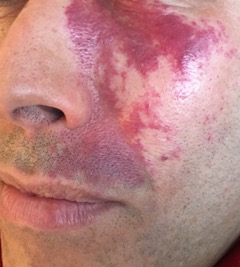What does a port- wine stain indicate?
PORT WINE STAIN :
A port wine stain usually appears on the face but can affect other are as of the body.
The condition gets its name because it looks like someone spilled or splashed dark red wine on the skin. It’s also called nevus flammeus. A port wine stain is a permanent birthmark that usually appears on the face. It starts as a smooth, flat, pink or red patch on a newborn. Over time, it may get larger, darker and thicker. Some port wine stains are associated with syndromes involving the blood vessels. Laser treatments may help fade the birthmarks.
WHAT ARE CAUSES OF PORT WINE STAIN ?
Port wine stains result from abnormally formed capillaries (tiny blood vessels under your skin). The capillaries dilate, which means they’re more open or stretched out than normal.
But scientists aren’t sure what causes the abnormal capillaries. There have been cases where multiple family members have it, even if there are no known genetic mutations. Port-wine stains are caused by an issue with capillaries, which are very small blood vessels.
Usually, capillaries are narrow. But in port-wine stains, they’re overly dilated, allowing blood to collect in them. This collection of blood is what gives port-wine stains their distinctive color. Port-wine stains may become larger or change shape as capillaries grow larger.
Port-wine stains on the scalp, forehead, or around your eyes, may be a symptom of a condition called Sturge-Weber syndrome.
WHAT ARE THE SYMPTOMS OF PORT WINE STAIN ?
In children, port wine stains are usually smooth. As a child grows, the birthmark grows too, but it stays in proportion. Port wine stains may get thicker and darker over time and start to feel like pebbles under the skin. They also may be more likely to bleed after injury, which can be difficult to control.
A port wine stain is a pink, red or purplish splotch on the skin. It has clear borders where the birthmark starts and stops.
These birthmarks can occur anywhere on the body, but most commonly on the:
- Face.
- Neck.
- Scalp.
Port-wine stains generally don’t cause any symptoms, aside from their appearance. They usually start out as red or pink. Over time, they can darken to a purple or brown color.
Other characteristics of port-wine stains include:
- Size. They can range in size from a few millimeters to several centimeters.
- Location. Port-wine stains tend to appear on one side of the face, head, and neck, but they may also affect the abdomen, legs, or arms.
- Texture. Port-wine stains usually start out being flat and smooth. But over time, they may become thicker or slightly bumpy.
- Bleeding. The skin of a port-wine stain may be more prone to bleeding when scratched or injured.
A healthcare provider can diagnose a port wine stain simply by looking at the skin.
These are generally diagnosed at birth. Healthcare providers will need your family history. Port wine stains are usually just a cosmetic issue, affecting only the skin. Your baby’s provider will check them for signs that there may be other health issues a syndrome like Sturge-Weber.
If the provider has any concerns or needs to rule out a medical problem, they may order other tests. Examples include:
- Eye tests to measure pressure in the eye.
- Imaging tests such as an X-ray, CT scan or MRI .
- Skin biopsy
Port wine stains that aren’t associated with other medical concerns don’t require medical treatment. But some people choose treatment because of:
- Increased risk of bleeding with trauma and associated risk of infections.
- Potential for thick, bumpy skin and disfigurement later in life.
- Self-esteem and socialization.
The most common treatment is laser therapy to shrink the blood vessels and fade the birthmark. The treatments are most effective in younger patients when the blood vessels are smaller.
Laser therapy treatments are brief, lasting a few minutes. Most people get repeat treatments every couple of months. The laser may make the skin red and sore, like a sunburn. If the treatments are very uncomfortable, you can ask for a numbing spray or cream. Very young children may even receive general anesthesia, so they sleep through the treatments.
Port-wine stains usually don’t require treatment. But some people choose to have them faded for cosmetic reasons. This is usually done with laser treatment that use a pulsed dye laser.
Other laser and light treatments include:
- Nd:YAG
- bromide copper vapor
- diode
- alexandrite
- intense pulsed light
Laser and light treatments work by using heat to damage the abnormal blood vessels. This causes the blood vessel to close up and disintegrate after a few weeks, helping to shrink, fade, or possibly remove port-wine stains.Most people will need several treatments, though the exact number depends on several factors, including skin color, size, and location.
Keep in mind that laser treatments may not completely remove a port-wine stain. But they may be able to lighten the color or make them less noticeable. Laser treatments may also cause some permanent scarring or discoloration. Laser treatment, your skin will be extra sensitive, so be sure to wear sunscreen and protect the affected skin following the procedure.


Comments
Post a Comment